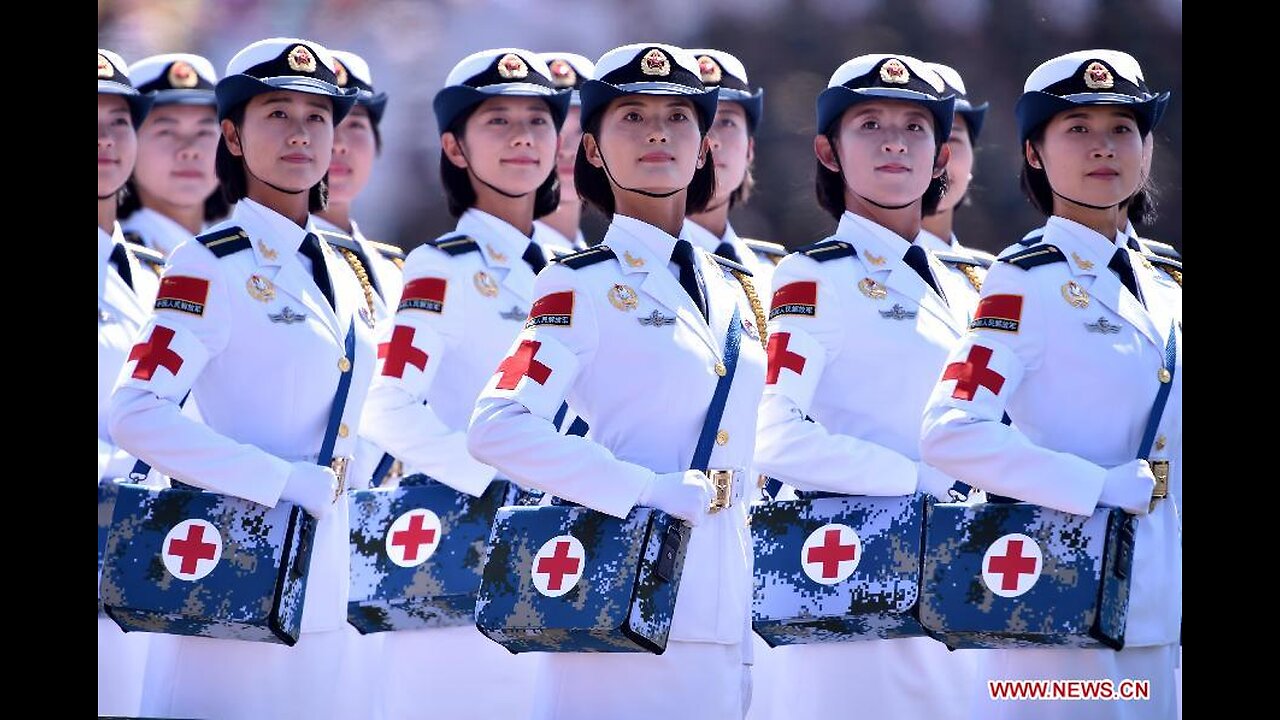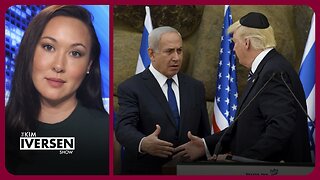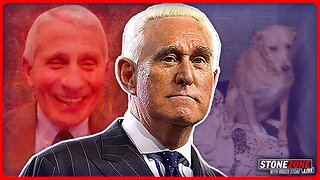Premium Only Content

Awesome Chinese Female Soldiers Light Up V-Day Parade Sexy Bethune Chinese !
Bethune international medical phalanx attends a parade in Beijing, capital of China, Sept. 3, 2015. China on Thursday held commemoration activities, including a grand military parade, to mark the 70th anniversary of the victory of the Chinese People's War of Resistance against Japanese Aggression and the World Anti-Fascist War. China’s V-Day parade countdown 76,000 troops & missile might expected. The military parade in Beijing on September 3, celebrating Japan’s surrender in World War II, is going to demonstrate some 500 units of China’s military hardware rolling across Tiananmen Square, accompanied by 12,000 troops.
The parade of the People's Liberation Army (PLA) will last over an hour and together with 500 vehicles of 40 types it will showcase over 200 Air Force aircraft, according to local media. Chinese authorities claim that up to 84 percent of the military hardware to take part in the parade has never been publicly presented before. A parade rehearsal conducted in late August exposed that China is preparing to roll out at least three types of ballistic nuclear missiles on to Tiananmen Square.
One of them is the Dong Feng-21D (DF-21D) antiaircraft-carrier medium-range ballistic nuclear missile, capable of engaging a moving target out at sea with the help of the Yaogan satellite constellation, delivered to orbit in 2006-2014. China's ‘Carrier-Killer’ has an alleged range of up to 2,000km and could be armed with either conventional explosives or a 300 Kt nuclear warhead.
Another missile expected to be on display on Thursday is the newest medium-range ballistic nuclear missile, the Dong Feng-26 (DF-26), a development from the DF-21. With a range of 3,500km it can reach foreign military bases, such as the island of Guam in the Pacific.
Also, Beijing is likely to present its newest strategic ballistic missile, the DF-5, which has an intercontinental range of 12,000km and could be armed either with a single, yet extensively powerful, 5 Mt nuclear warhead, or with 10-12 less powerful independently targetable warheads. The agency also says that a new long range bomber will fly over the parade, along with other military aircraft: fighter jets, carrier-launched aircrafts, sea patrol aircrafts, tankers, assault helicopters etc. For the first time in the history of Chinese military parades, female soldiers will march on Tiananmen Square.
Also for the first time, the event will be accompanied by a 2,400-strong PLA’s massed choir to sing some 30 songs during the parade.
Veterans of the China’s War of Resistance Against Japanese Aggression, fighting for independence of their country in 1930s-40s, with their average age in well in the 90s, will be brought to the parade on buses. Just as in the Victory Day parade in Moscow this year, Chinese troops will not march alone in Beijing. Troops from Belarus, Cuba, Egypt, Kazakhstan, Kyrgyzstan, Mexico, Mongolia, Pakistan, Serbia, Tajikistan and Russia will join them. Each country will bring 75 servicemen to the Chinese capital. Six more countries: Cambodia, Fiji, Laos, Vanuatu and Venezuela, will be represented by small units of up to seven soldiers.
Russia will be represented with 154th Commandant Regiment stationed in Moscow, which is expected to close the parade of the troops.
Not all world leaders extended an invitation are going to attend the Victory Day parade in Beijing. Leaders of the Western powers and NATO member states will not travel to China and are to be represented by lower-ranking officials and diplomats – apart from the Czech Republic, which will be presented by President Miloš Zeman. Although Japanese Prime Minister Shinzo Abe was officially invited, he declined.
North Korean leader Kim Jong-un also declined the invitation, saying he will oversee a parade at home, while South Korean President Park Geun-hye will be in attendance.
Among other heads of state to come to Beijing are South African President Jacob Zuma, Pakistan’s President Mamnoon Hussain will also be present, as well as leaders of the four Central Asian states that are part of the China-based Shanghai Cooperation Organization (SCO).
Russian President Vladimir Putin will have a two-day visit to Beijing to conduct a number of meetings and sign about 30 official documents with the Chinese government. Already dubbed Beijing’s “main guest” at the event, Putin’s visit begins on the evening of September 2. Tune in to RT at 02:00 GMT to watch the WWII Victory parade in Beijing, China.
The National Day Parade (Chinese: 国庆阅兵), officially the National Day of the People's Republic of China Parade (Chinese: 中华人民共和国国庆阅兵), is a civil-military parade event held at Tiananmen Square in Beijing, the capital of the People's Republic of China, on the National Day of the People's Republic of China on 1 October. It is organized by the People's Liberation Army, the People's Armed Police and the Militia, as well as civilian groups of the Chinese Communist Party (CCP). It has been held every decade since 1959, annually from 1950 to 1959, and has been broadcast live on China Central Television since 1984. The most recent National Day parade took place on October 1, 2019, on the 70th anniversary of the People's Republic of China.
Since the parade of 1950, parades have been held on the city's Tiananmen Square to mark the anniversary of the official foundation of the PRC and today these have been held every 10th year (a format which began in 1999 to mark the golden jubilee anniversary of nationhood), formerly there were yearly parades held until 1959 when the CCP decided that the holiday would be celebrated "with frugality". Parades were also held in 1964, 1966, 1969, 1970 and 1984.
The parade is presided by the paramount leader in his political duty as General Secretary of the Chinese Communist Party and constitutional mandate as the supreme commander of the PLA and chairman of the Central Military Commission, since 1984. He has also inspected the parade in person. The parade commander is a general officer of the PLA with the rank of Lieutenant General or Major General, with the position of commander of the Central Theater Command or as a high-ranking member of the CMC's present 15 departments. Until 1959, during the years that the parade was held in a nationalized form of the Soviet tradition, the parade was inspected by the Minister of National Defense, a high-ranking billet occupied by either a General or (before 1984) a Marshal (before 1954 the Commander in Chief of the PLA). The event's master of ceremonies has either been the Party Committee Secretary of Beijing or a high-ranking member of the Central Committee, CCP.
In past parades a card stunt display was assembled at the square grounds made up of thousands of young men and women from the capital and from various parts of the country (abolished 2015), while student battalions of the Young Pioneers of China are assembled in the sides of the Massed Bands, led by the Senior Director of Music of the PLA Military Bands Service, made up of around 1,900 male and female bandsmen from the service branches from military bands stationed nationwide. The Pioneer Battalions carry the red battalion colours which can be seen in front of their respective contingents.
The flag raising ceremony follows the arrivals, but unlike the normal ceremony the color guard company, as a 21-gun salute is fired by the gunners of the State Honors Artillery Battery of the Beijing Garrison Command, marches off from the sides of the Monument to the People's Heroes, forms up, and takes its place at the center of the grounds nearest the Massed Bands, with the Flag of China now being placed into the flagpole by the color officer, who has just been given the color from the color guard. The segment was introduced in 1999 as a reenactment of sorts of the raising of the national flag in the square in 1949.
With that concluded and the card stunt now in position, the master of ceremonies gives the announcement on the microphone: Ladies and gentlemen, please stand for the raising of the national flag and the singing of the National Anthem! By then, the color officer now orders the salute and the massed bands play the National Anthem March of the Volunteers as the color company presents arms, after the anthem is played the color company orders arms and stands at ease.
As the armed linemen of the Beijing Capital Garrison take their places, the paramount leader then descends to the grounds of the Tiananmen Gate via the elevator and rides on an open top Hongqi L5 for the inspection segment, with around 4,000 to 16,000 military personnel of the PLA, PAP and militia formations assembled by battalions, as well as the 9,000 strong personnel of the mobile column with around 400-900 vehicles. As he arrives at the front of the gate at the Chang'an Avenue, the parade commander (since 1954 the Commander of the Beijing Military Region and later the Central Theater Command) arrives in a similar limousine to inform the paramount leader of the commencement of the inspection of the parade.
The report done, the paramount leader, as the Massed bands play, then inspects the formations, each of its leaders ordering a salute as he passes by and the battalions each present arms (eyes right for unarmed formations and the port arms when using modern rifles), after which they stand at attention. Since 1984 the regular honor guard companies of the Beijing Garrison Honor Guard Battalion (since 2015 the final company is a women's company) together with its national colour guard unit are the first in line for the inspection segment of the parade.
Whenever the paramount leader passes by an assembled militia or battalion, the soldiers will salute, and the paramount leader will greet the soldiers by saying "Hello, comrades!" (同志们好!) or "[Thank you for your] hard work, comrades!" (同志们辛苦了!) The soldiers respond saying "Hello, Mr. Chairman!" (主席好!) or "[We] serve the people!" (为人民服务!)
Following the inspection, the paramount leader returns to the Tiananmen Gate to give the national keynote holiday address, at the same time the commander takes his place in the gate as well and the parade formations are now formed in review order as the mobile column now forms up in addition to the fly-past.
In the 2019 parade, the order was reversed, this time the paramount leader gives the opening keynote address before departing from the gate for the parade inspection.
The order Commence the parade! from the parade commander atop Tiananmen Gate is the signal for the parade formation to march past the gate, wherein the dignitaries are gathered, while the crowds are assembled on the stands around the gate which include veterans of the PLA, Young Pioneers, representatives of state and private businesses and distinguished citizens as well as the civil service and the diplomatic corps and foreign press representatives. As the Massed Bands play the Parade March of the PLA, a special parade version of the Military Anthem of the People's Liberation Army, following the fly past of the national and party flags and the flag of the PLA, alongside, in special years, a helicopter formation honoring the number of years of nationhood, the ground column marches first as the General Secretary and other party, state and military leaders take the salute of each of the contingents marching past the saluting stand. Since 1984 the regular honor guard companies of the Beijing Garrison Honor Guard Battalion, including the aforementioned female company, are the first to march past the dignitaries, led by the colour guard carrying the flag of the PLA, which serves as the de facto national colour, alongside the national and party flags that both precede it. Each of the battalions that march past are made up of the following Officers of the CMC, MND and the People's Armed Police.
Until the parade of 1959, the PLA, PAP and militia marched separately during the parade proper (the militia marched as part of the civil column). Each of the battalions consists of 350 soldiers (14 rows of 25 soldiers) and are led by the battalion commander and the battalion political commissar, who march at the lead of their unit.
A mobile column then follows which is also formed into battalions, but with the command personnel mounted on their vehicles as they render honors. These are made up of the mostly nationally produced military vehicles and equipment in service and being introduced to serve the needs of the modern PLA. A notable unit to serve in the mobile column is the female contingent from the Bethune Medical College, which was introduced to the parade in 1984. Following this column, the fly-past of aircraft from the Ground Forces, Navy and Air Force follows suit.
-
 3:00
3:00
What If Everything You Were Taught Was A Lie?
4 days agoFifth Basic Law Of Human Stupidity "Open Your Eye Before You Die" Greatest Deception Of Our Time
2.76K4 -
 5:44
5:44
DropItLikeItsScott
10 hours agoA Must Have Shotgun - GARAYSAR Fear 116
9272 -
 56:14
56:14
PMG
16 hours agoHannah Faulkner and John Strand | BLANKET PARDON FOR ALL J6er's
1.61K -
 48:51
48:51
State of the Second Podcast
13 hours agoWhy Does Palmetto State Armory Keep Winning?
1.57K2 -
 32:01
32:01
SB Mowing
25 days agoHer Tears Said It All: “My Prayers Have Been Answered”
21.6K34 -
 3:28:55
3:28:55
Price of Reason
13 hours agoTrump Means Business! Disney's F4 Hail Mary Pass! Assassin's Creed Shadows Art Book SUCKS?
64.1K12 -
 8:00:07
8:00:07
SpartakusLIVE
11 hours ago#1 Shadow BANNED Hero
37.6K -
 2:17:46
2:17:46
Kim Iversen
11 hours agoTrump To SMUG Netanyahu: Let's Clear “All” Palestinians From Gaza! | RFK Jr, Tulsi Move On To Round Two
85.6K439 -
 30:25
30:25
Standpoint with Gabe Groisman
1 day agoDemocrats Are Stalling Trump Appointments with Senator Rick Scott
101K24 -
 1:00:24
1:00:24
The StoneZONE with Roger Stone
12 hours agoAnthony Fauci’s Brutal History Of Animal Torture Exposed! | The StoneZONE w/ Roger Stone
69.2K20